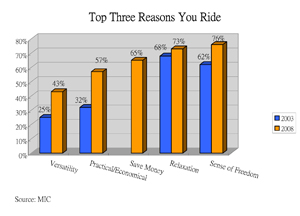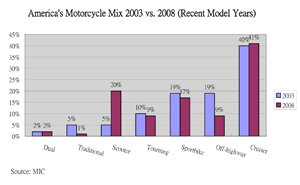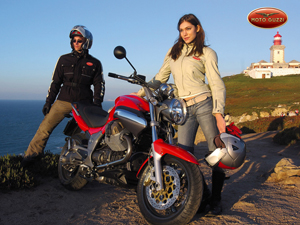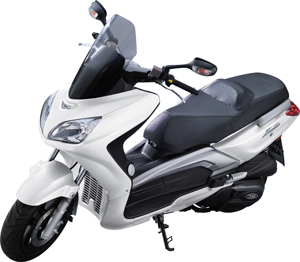Motorcycle Industry Council President Sheds Light on Trends in the U.S.
2009/10/08 | By Quincy LiangThe 4th Taiwan International Motorcycle Industry Show (Motorcycle Taiwan 2009), the biggest and only international motorcycle show on the island, was lent more credibility by inviting as VIP Tim Buche, president of three major motorcycling and performance vehicle related organizations in the United States: the Motorcycle Industry Council (MIC), Specialty Vehicle Institute of America (SVIA), and Motorcycle Safety Foundation (MSF). Buche talked with a journalist of the Taiwan Motorcycle and Parts Guide (TMG), published by the CENS, offering various views on motorcycling, market trends, changing ridership, buying decisions etc.
Sounding as the socially-correct industry president, Buche says: "Motorcycle Taiwan 2009 is very impressive this year. I appreciate seeing the new technologies, products and the customization show. I am amazed by the personality and individuality that riders are putting into their scooters!"
The MIC is a non-profit, national trade association that promotes and lobbies for motorcycling and the U.S. motorcycle industry--a formidable mission accomplished through official lobbying, statistics compilation, communications, technical and aftermarket programs. Its membership consists of more than 300 manufacturers and distributors of motorcycles, scooters, parts and accessories, as well as allied trades such as publishing, insurance and consultants; though dealers, clubs and individuals are ineligible for membership, the MIC works with these groups on issues of mutual interest.
When asked to offer information about the U.S. powersports market and suggestions, Buche, however, says that he needs to be impartial and neutral to brands because "I want them all to make great products that inspire consumers and increase the size of our market."


Buche advises producers that want to successfully tap the U.S. market to listen to consumers, or to be more market-driven. In addition, he adds that ample supply of spare parts and after-sales services are very important to American consumers and dealers. Motorcycling is a universal language, with riders from various countries speaking slightly different versions of the same lingo, so suppliers should listen and try to understand their language, according to Buche.
Many people want to change the industry or market by pouring efforts into product development and innovation, Buche says, but they stress "now" too much and neglect the future.
New riders are the future of the market and industry, Buche says. That means producers should have vision and new technologies, which are also new opportunities. “I believe to move a motorcycle is easier than a car, so the motorcycle industry, no matter in technology, innovation, or market structure etc., has bigger chance to change.”
U.S. Market Trends
As the most comprehensive collector of market statistics, MIC is always ahead in recognizing market changes. Buche outlines some of these trends.
With slowing sales, fewer machines are available at dealerships, but demand is still high as motorcycling is without doubt a great recreation for fun and freedom. "MIC is actively asking the U.S. government to bail out the motorcycle industry, including financing inventory to offer more options for consumers, as well as incentives for motorcycle purchases etc." the president says. "We know that amid the financial storms, motorcycle sales in the U.S. fell only 3.3% in 2008, much better than automobile sales. We do not forecast this year's market, but believe that sales will improve. We are very optimistic because we see demand exists, and sales will turn around with some incentives offered.”
Another reason for Buche's optimism is the gas price in the U.S., currently hovering at US$4 per gallon. "Most people think rising gas prices will lead to clear increase in sales of 250cc to 500cc motorcycles (and scooters), which are relatively affordable.”
More Female Riders
Another market trend, according to Buche, is the increasing female ridership. "Women riders are increasing because they don't want to be passengers or controlled again. In 1998, the ratio of women riders in the U.S. was only 8.2% but the ratio has risen to 9.6% in 2003 and to 12.3% in 2008. Even more significant, of about 2.5 million people who rode motorcycles in the U.S. in 2008, 23% or 5.75 million were women."
Breaking down the motorbike categories, Buche says, MIC's surveys show that most women riders prefer cruisers at 36%, while scooters are a very close No. 2 at 34%, sport bikes follow at 16% compared to others all below 10%, including touring, traditional, dual and off-highway models.
Female riders are very influential, Buche says, because most will bring other women riders along. In addition, most married women have the right to decide for their children purchase priorities.
In the U.S., Buche continues, the motorcycle mixture is changing too. Among riders who purchased recent models, the percentage of scooters has skyrocketed from 5% in 2003 to 20% in 2008. However, off-highway bikes dropped from 19% to 9. Other bike models have remained relatively stable, with cruisers still being the most popular at 41%.

More Generation Y people are becoming motorcycle owners, according to Buche. In 2003, Baby Boomer (born 1946-1964) motorbike owners outnumbered Generation Y at a ratio of 5-to-1 in the U.S., with such ratio changing to 2-to-1 by 2008 as the Generation Y (born after 1979) motorcycle owners grew by 135%.
Such trend is not surprising since Generation Y members have grown beyond teen years and are more likely to be able to afford motorcycles, Buche explains. This trend, however, is quite important, for Generation Y riders behave differently from Baby Boomers in purchasing and riding habits. In most cases, Generation Y riders are more likely to be influenced by family and friends, more likely to take safety course which will in turn influence purchase decisions, and of course, they tend to ride different types of motorcycles.
Furthermore, Generation X (born 1965 to 1979) and Boomers, according to Buche, prefer cruisers at 47% and 55%, respectively, compared to only 23% for Generation Y motorcyclists. About 35% of the younger Generation Y riders are on sport bikes, compared to 22% for Generation X and only 4% of Boomers. According to Buche, preferences for traditional motorcycles and scooters are relatively consistent across generations, ranging from 6% (Boomers) to 12% (Mature or born before 1946).
Slower Aftermarket
The motorcycle aftermarket, according to the president, underwent a clear 44% slowdown in comparing 2003 and 2008 spending, including for accessories and maintenance. Spending on tires were down 19% (US$289 in 2003 and US$234 in 2008), with apparel down 14% (US$459 in 2003 and US$394 in 2008), the president says, while repairs and maintenance remained relatively unchanged at about US$280 per year (US$281 in 2003 and US$278 in 2008).
Buche attributes the spending decline to high gas prices and believes US$4 per gallon is the cutoff.
Ninety-six percent of brand-new motorcycles are purchased from dealers, but only 20% of all used motorcycles sold in the U.S. Considering that used motorcycles represent 54% of all motorcycles sold in a year, this segment represents a significant, untapped opportunity to dealers in both vehicle and aftermarket sales, Buche says.

Buche identified several decision-making factors influencing buying and riding of motorcycles in the U.S., which are of interest to suppliers eying the American market.
According to the president, the top-five factors affecting Americans' decision to buy a motorcycle include: availability of test rides, dealership, advice from family/friend, magazine reports, and Internet (which was No. 7 in 2007). That means, he says, “touch and feel” is critical in decision making.
While "fun" remains the single-most important reason to ride a motorcycle, economy and escapism show the biggest gains in importance, the president says. Versatility is becoming more important: rising 18 percentage-points from 25% in 2003 to 43% in 2008; practicality/economy has risen 25 percentage-points from 32% in 2003 to 57% in 2008; while 65% of surveyed riders said that "budget" (which was not included in the 2003 survey) is a top-three reason to ride.
Nothing compares to motorcycling for sense of freedom, relaxation etc., claims the motorcycling fan and association president, even amid a recession.
E-Scooter Potential
Somewhat philosophical, evasive about the future of e-scooters in the U.S. market, Buche says to pay attention to the Big Picture by considering that an electric scooter with high efficiency and durable batteries may be great, but is the maker green enough?
The president thinks that governments, research units, producers, and consumers need to be wary of conventional wisdoms as they consider the seemingly appealing electric-scooter. "Many motorcyclists like new technologies," he says, "but what is the real need should be our first question. Is it transportation, speed, or other pursuits?”




